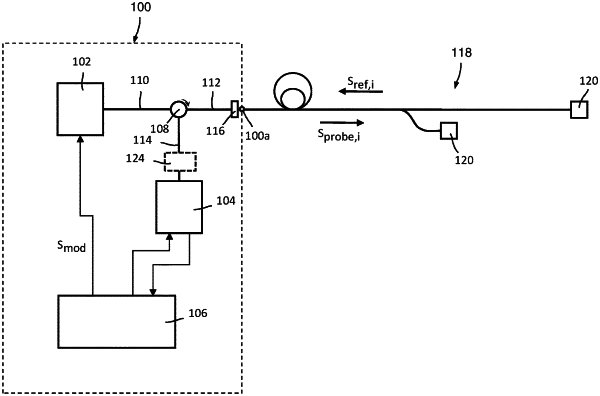| CPC G01D 5/35329 (2013.01) [G01K 11/32 (2013.01)] | 16 Claims |

|
1. A method for interrogating at least one optical sensor that is provided within or connected to an optical path at a sensor position, the optical path connecting the optical sensor to a near end of the optical path, wherein the at least one optical sensor has a known frequency-dependent course of its reflectivity that is changed by a physical parameter to be sensed, especially the temperature or humidity of the environment surrounding the at least one optical sensor or the pressure being exerted onto the at least one optical sensor, the method comprising the steps of:
(a) feeding at least two optical probe signals (Sprobe,i) having differing optical center frequencies to the near end of the optical path,
(i) wherein the at least two optical probe signals (Sprobe,i) are time-shifted versus each other in a predetermined manner when being fed to the near end of the optical path, or
(ii) wherein a predetermined time shift between the at least two optical probe signals (Sprobe,i) or corresponding optical reflection signals (Sref,i) is introduced within the optical path or within an optical receiver using a chromatic dispersion generating component);
(b) detecting reflected optical power portions of the at least two probe signals (optical reflection signals (Sref,i)) created by the at least one optical sensor depending on its frequency-dependent course of the reflectivity and the optical frequencies of the at least two optical probe signals (Sprobe,i), assigning each optical reflection signal (Sref,i) detected to one of the at least one optical sensor and assigning a correct optical frequency to each optical reflection signal (Sref,i) detected using a known round-trip delay of the at least two optical probe signals (Sprobe,i) between the near end and the respective sensor position and/or using the time shift relation between the at least two optical probe signals (Sprobe,i); and
(c) determining an absolute value or a value range or a change of a value or value range of the parameter to be sensed using the presence of one or more of the following physical conditions:
the optical reflection signals (Sprobe,i) or the maximum optical power or the optical energy thereof,
the frequency-dependent course of the reflectivity of the at least one optical sensor and its dependency on the parameter to be sensed, and
the optical frequency of each of the optical reflection signals (Sref,i) detected,
or using one or more dependencies that link these physical conditions.
|